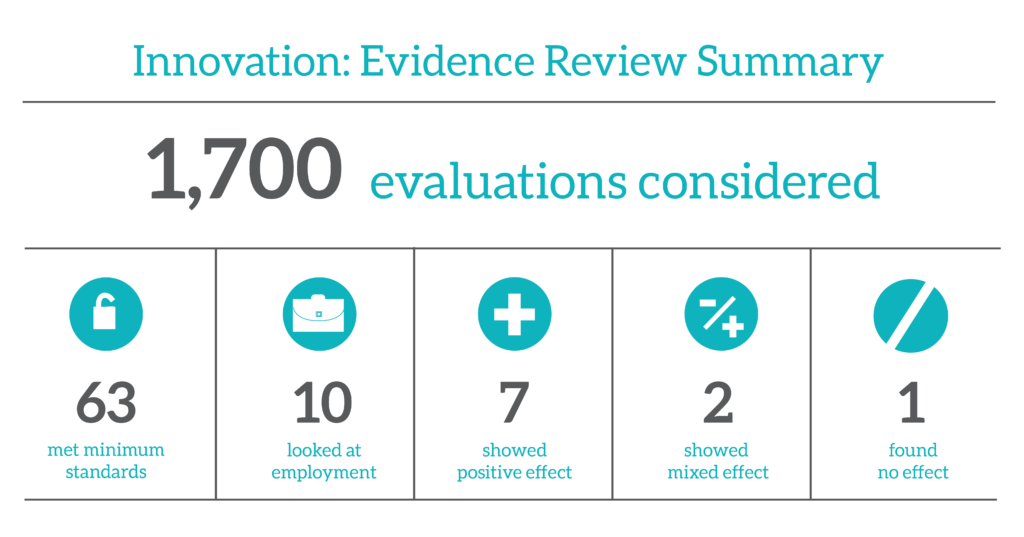Evidence review (PDF) published in October 2015.
Support for innovation, including tax credits and grants, loans and subsidies, can have an impact on activity, but effects are not always positive.
What is innovation?
Innovation refers to private sector research and development (R&D) that aims to generate or commercialise new ideas, products, services, or processes. Government support on innovation and R&D can include grants, loans and subsidies. We include the following policies in our work:
- Innovation-policy schemes providing public funding for innovation projects
- National funds for research in science and technology
- Subsidised government loans for R&D activities
- Regional subsidies to support public and private R&D activities.
Government can also support R&D through tax credits, including:
- Incremental-based credits, based on the difference between historic and current R&D spend
- Volume-based credits, based on the current volume of R&D spend.
The rationale: How does innovation deliver growth?
Innovation helps firms to develop smarter ways of working, which could result in lower costs or new products or services, and ultimately lead to increased profits, higher productivity and increased economic growth.
Government support is needed as the returns to innovation tend to be highly uncertain, so individual firms often underinvest in innovation. R&D also usually has ‘spillover’ effects, meaning that the gains to society can far outweigh the benefits of individual innovators.
Evidence review: What does the evidence say about innovation?
Our evidence review considered over 1,700 studies and policy evaluations from the UK and other OECD countries, covering all aspects of support for innovation. The evidence was split into two categories: R&D grants, loans and subsidies; and R&D tax credits. It found 63 evaluations that met our minimum standards, 42 for R&D grants, loans and subsidies, and 21 for R&D tax credits.

R&D grants, loans and subsidies
What the evidence shows:
- R&D grants, loans and subsidies can positively impact R&D expenditure, although effects are not always positive.
- R&D grants, loans and subsidies can raise innovative activity in recipients, although again effects are not always positive. The effects differ across types of innovation, and are weaker for patents than for (self-reported) measures of process or product innovation.
- R&D grants, loans and subsidies can positively impact productivity, employment or firm performance (profit, sales or turnover). There is some evidence that support is more likely to increase employment than productivity.
- R&D grants, loans and subsidies are more likely to improve outcomes for small to medium-size companies than for larger ones. In part, this may be because for larger firms, public support makes up a relatively small amount of overall R&D spend, so positive effects are harder to detect. Smaller firms may also be more likely to formalise processes in anticipation of, or response to, a grant, so that some innovation-related spend is reclassified as R&D.
- Programmes that emphasise collaboration perform better than those that just support private firms (as well as those where the programme focus is unclear). Encouraging collaboration might have an additional positive effect on the likelihood that an R&D support programme generates positive effects on outcomes of interest.
- Programmes that target particular production sectors appear to do slightly worse in terms of increasing R&D expenditure and innovation, compared to those that are ‘sector neutral’.
Where the evidence is inconclusive:
- Evidence on the extent to which public support crowds out private investment is mixed.
Where there is a lack of evidence:
- There is little impact evaluation evidence on key aspects of programme design, such as eligibility criteria and targeting programmes by firm size.
- Relatively few evaluations consider the timing of effects. In particular, there is a lack of studies considering long-term impacts of interventions (ten years plus). However, the small number of studies that are able to consider the time profile of effects, do not suggest that programme effects get stronger over time.
- Relatively few evaluations consider more than one element of the ‘chain’ from increased R&D spend, through innovation, to improved firm performance. Results from these studies are mixed.
- Programme spend and operational cost data is rarely available to evaluators. This makes it very hard to assess the cost-effectiveness of public R&D grants and subsidies.
R&D tax credits
What the evidence shows:
- R&D tax credits can positively impact R&D expenditure, although effects are not always positive.
- Impacts may depend on firm size with small firms slightly more likely to experience positive benefits. Smaller firms may face greater financial constraints, making them more responsive to changes in tax credits. However, smaller firms may also reclassify innovation-related spending as ‘formal’ R&D.
Where the evidence is inconclusive:
- It is hard to reach any strong conclusions on differences between the different programme types in terms of effectiveness.
Where there is a lack of evidence:
- Most shortlisted studies focus only on R&D effects of tax credits, and there is surprisingly little evidence on the impact of R&D tax credits on innovation (as measured by patents or self-reported innovative activity, for example). The available studies suggest that tax credits can have a positive impact on innovation, both at firm and area level.
- There is surprisingly little evidence on the effect of R&D tax credits on wider economic outcomes and it is hard to draw firm conclusions on the impact.
- Relatively few evaluations consider more than one element of the chain from increased R&D spend, through innovation, to improved firm performance. Results from these studies are generally positive.
- None of the shortlisted evaluations consider the timing of effects.
Innovation policies may raise R&D spending but we know much less about whether or how this feeds through to greater innovation, better firm performance or longer term economic growth, particularly at the local level.
Lessons:
- The evidence urges caution on the role that more localised innovation policy could play in driving local economic growth – we know very little about whether or how increased R&D activity feeds through to greater innovation, better firm performance or longer term economic growth, particularly at the local level.
- Many broader economic benefits are likely to ‘spill over’ beyond the immediate area in which the policy is implemented. This might still result in a net benefit for the place implementing the policy, but such spillovers reduce the economic benefits to individual areas and strengthen the case for national policy.
- Local R&D support programmes could also result in inefficiently high levels of support if footloose firms are able to extract more generous support from competing local areas regardless of any net beneficial impact.
Downloads
Toolkits: Advice on designing innovation programmes
In addition to the evidence review, we have two policy design toolkits to help policy makers to make informed decisions. Each toolkit covers a specific type of innovation policy. The toolkits consider a broader evidence base than the evidence review.
Case studies: Advice on how to evaluate innovation programmes
The evaluation of the impact of innovation is not straightforward. Often only certain types of firms consider introducing new technologies or processes. This complicates assessing the impact of programmes since those who decide to apply are likely to have different set of characteristics, compared to those that do not even apply.
To help improve evaluation of innovation, we have three case studies that give examples of how previous policies have been evaluated.
Each evaluation case study has met our minimum standard of evidence, which means it (at a minimum) compares what changed for the businesses that benefited from an intervention with what changed over the same time frame for otherwise comparable businesses that didn’t benefit, or that received a different type of intervention. The three case studies use two different approaches: a randomised control trial (RCT), and statistical approach to try to ‘strip out’ the impact of other factors that could have affected outcomes in both the beneficiary and control groups.
Read more about how to evaluate, and why we think it can be helpful to learn from previous approaches in our how to evaluate guide. You can also read more about different evaluation methods in our scoring guide.






